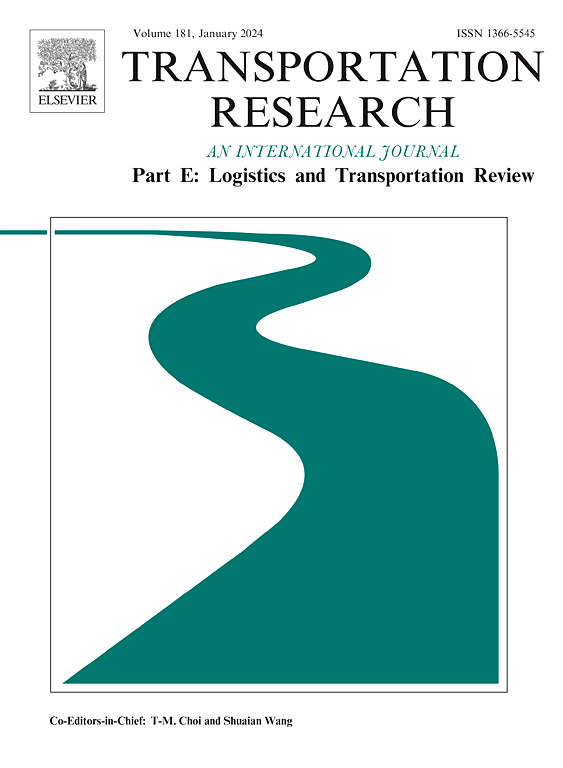通过电动公交车网络的重新设计提高多模式公共交通系统的复原力
IF 8.3
1区 工程技术
Q1 ECONOMICS
Transportation Research Part E-Logistics and Transportation Review
Pub Date : 2024-10-29
DOI:10.1016/j.tre.2024.103810
引用次数: 0
摘要
由电动公交车网络和地铁网络组成的多模式公共交通系统在满足城市地区日常交通需求方面发挥着至关重要的作用。然而,由于电动巴士网络与地铁网络之间的连接不足,导致多模式公共交通系统的恢复能力较差。当地铁线路或地铁站发生故障时,滞留的乘客无法通过公交线路迅速疏散。因此,运营商需要重新设计多模式公共交通系统,加强电动公交网络与地铁网络之间的整合。由于改造固定的地铁网络具有挑战性,因此我们重点介绍电动公交网络的重新设计方案,使多模式公共交通系统在中断情况下表现出所需的弹性。本文提出了一个两级框架,即战术层面的电动公交网络重新设计和规划层面的资源调配。针对战术层面的重新设计问题,本文设计了一种量身定制的分支加价格算法,以生成高质量的电动公交网络重新设计解决方案。对于规划层面的资源配置问题,本文基于重新设计的电动公交网络,考虑不确定的乘客需求和地铁容量,确定充电设施的位置和电动公交车的数量。我们为资源部署问题提出了一个双层鲁棒优化模型,并开发了一种定制的列和约束生成算法来解决该问题。最后,本文在北京的一组实例中测试了所开发模型和算法的性能。本文讨论了不确定性预算、电动公交车数量、公交车容量和电动公交车充电时间对系统性能的影响。本文章由计算机程序翻译,如有差异,请以英文原文为准。
Resilience enhancement of multi-modal public transportation system via electric bus network redesign
The multi-modal public transportation system incorporating the electric bus network and the metro network plays a crucial role in meeting the daily transportation demands in urban areas. However, the inadequate connectivity between the electric bus network and the metro network has resulted in poor resilience of the multi-modal public transportation system. When disruptions occur at metro links or metro stations, stranded passengers cannot be rapidly evacuated through bus lines. Therefore, operators need to redesign the multi-modal public transportation system to enhance the integration between the electric bus network and the metro network. Since it is challenging to modify the fixed metro network, we thus focus on introducing redesign plans for the electric bus network, enabling the multi-modal public transportation system to exhibit the desired resilience in scenarios of disruptions. This paper proposes a two-level framework integrating electric bus network redesign at the tactical level and resource deployment at the planning level. For the redesign problem at the tactical level, this paper designs a tailored branch-and-price algorithm to generate high-quality redesign solutions for the electric bus network. For the resource deployment problem at the planning level, this paper determines the locations of charging facilities and the number of electric buses based on the redesigned electric bus network, considering uncertain passenger demands and metro capacities. We propose a two-layer robust optimization model for the resource deployment problem and develop a tailored column-and-constraint generation algorithm to solve it. Finally, this paper tests the performance of the developed models and algorithms on a set of instances in Beijing. The impact of the uncertainty budget, the number of electric buses, bus capacity, and charging time of electric buses on the system performance is discussed.
求助全文
通过发布文献求助,成功后即可免费获取论文全文。
去求助
来源期刊
CiteScore
16.20
自引率
16.00%
发文量
285
审稿时长
62 days
期刊介绍:
Transportation Research Part E: Logistics and Transportation Review is a reputable journal that publishes high-quality articles covering a wide range of topics in the field of logistics and transportation research. The journal welcomes submissions on various subjects, including transport economics, transport infrastructure and investment appraisal, evaluation of public policies related to transportation, empirical and analytical studies of logistics management practices and performance, logistics and operations models, and logistics and supply chain management.
Part E aims to provide informative and well-researched articles that contribute to the understanding and advancement of the field. The content of the journal is complementary to other prestigious journals in transportation research, such as Transportation Research Part A: Policy and Practice, Part B: Methodological, Part C: Emerging Technologies, Part D: Transport and Environment, and Part F: Traffic Psychology and Behaviour. Together, these journals form a comprehensive and cohesive reference for current research in transportation science.

 求助内容:
求助内容: 应助结果提醒方式:
应助结果提醒方式:


